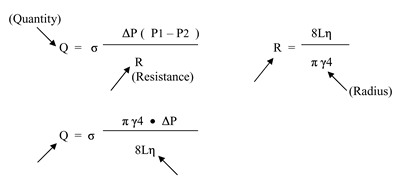Key Concepts
The concept behind ECP is based on providing additional blood ciculation by increasing the supply of oxygenated blood to the myocardium to overcome reduced coronary artery blood flow during diastole. During diastole, up to 80% of coronary blood flow occurs. To understand how ECP treats myocardial ischemia, you must study hemodynamics – factors concerning blood flow within the circulatory system. Let us look at the hemodynamic formula to understand the principles of how blood flows through blood vessels. The relationships between flow quantity, pressure, and resistance are given below:

In this formula, Q represents a quantity of blood flow which is related to the pressure and resistance. Pressure is represented by ΔP, which means pressures side (P1) to side (P2), and it is a direct ratio related to the quantity of the blood flow. Resistance is represented by R, which is an inverse ratio to the quantity of the blood flow and also related to the blood vessel radius. In the formula, the “π”, “η”, and “L” all are recognized as constant.
As flow and resistance are inversely related, an increase in resistance will decrease the flow. However, changes in perfusion pressure will also effect flow.
The rapid inflation and deflation of ECP treatment rhythmically pushes blood from the patient’s lower torso into the heart muscle and improves collateral blood circulation and growth of smaller blood vessels. The treatment: 1) increases blood pressure to coronary arteries while the heart is resting (diastolic). 2) increases the return rate of blood to the heart; and 3) lowers the pressure the heart must pump against (systolic). In addition, increased blood pressure and changes to blood vessel radius will directly affect the blood. For example, a 12% increase in the radius of the blood vessel results in an increase of 57.4% in blood flow to the coronary arteries. The overall effect is that these actions increase the amount of blood and oxygen supplied to the heart and decrease the heart’s workload when it contracts.

